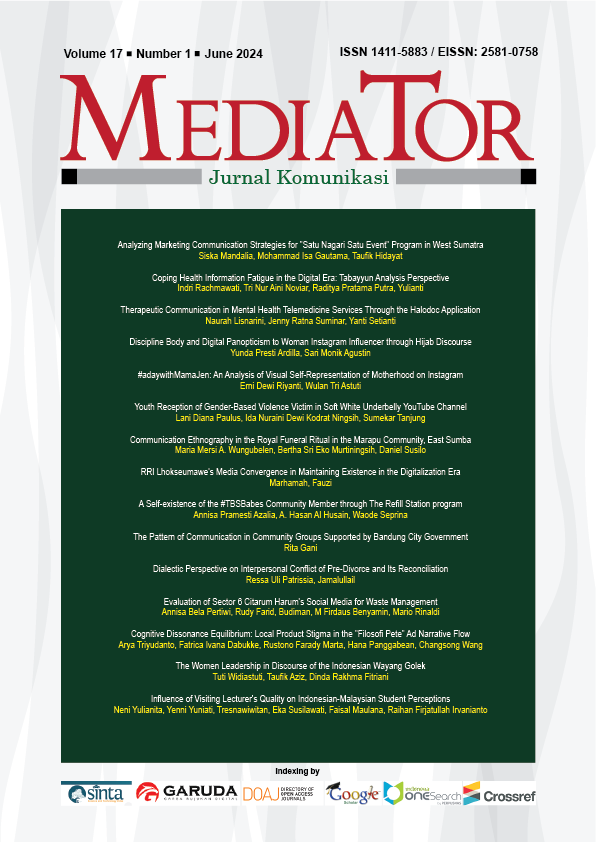Youth Reception of Gender-Based Violence Victim in Soft White Underbelly YouTube Channel
DOI:
https://doi.org/10.29313/mediator.v17i1.2630Keywords:
audience reception, gender-based violence, prostitute, youtube, soft white underbellyAbstract
Soft White Underbelly is a YouTube channel that produces content of interviews with marginalized people in America. It uncovers stories of stigmatized people and reveals the systemic inequality behind their presence. Gender-based violence (GBV) is one of the issues addressed on this channel. It portrays how prostitutes are victims of GBV. The author applied Stuart Hall’s audience reception theory. The theory proposes that media messages are not static. Hall suggested that expectations and prior knowledge influence their text interpretation. This research investigates how young audiences perceive portrayals of GBV victims in Soft White Underbelly's videos on prostitution and explores the factors that influence these perceptions. A qualitative method was adopted, employing audience reception analysis as the approach. Informants were international YouTube users between the ages of 18 and 30. The study finds various receptions, influenced by social factors, media habits, educational levels, personal experiences, and economic factors. Furthermore, this research confirms that Hall's reception theory is evident in today's audience reception. The findings demonstrate how viewers can develop critical awareness, interpret media texts, and disseminate them back into their social environment.
References
Annisa, F. (2023). Memahami Khalayak Media melalui Model Encoding/Decoding. In M. E. Sokowati & T. H. N. Rochimah (Eds.), Memahami Khalayak Media dalam Beragam Perspektif (pp. 111–133). Gramedia.
Arias, E. (2019). How Does Media Influence Social Norms? Experimental Evidence on the Role of Common Knowledge. In Political Science Research and Methods (Vol. 7, Issue 3). https://doi.org/10.1017/psrm.2018.1
Armstrong, E. G. (1981). The Sociology of Prostitution. In Sociological Spectrum (Vol. 1, Issue 1). https://doi.org/10.1080/02732173.1981.9981620
Bows, H., & Fileborn, B. (2020). Space, place and GBV. In Journal of Gender-Based Violence (Vol. 4, Issue 3). https://doi.org/10.1332/239868020X15983760944114
Colliver, B., & Coyle, A. (2020). ‘Risk of sexual violence against women and girls’ in the construction of ‘gender-neutral toilets’: A discourse analysis of comments on YouTube videos. Journal of Gender-Based Violence, 4(3). https://doi.org/10.1332/239868020X15894511554617
Denis McQuail. (2010). McQuails Mass Communication Theory by Denis McQuail. In SAGE Publications Ltdications Ltd (Vol. 6).
Dewi, I. N. (2012). Reception Audiens Ibu Rumah Tangga Muda Terhadap Presenter Effeminate dalam Program-program Musik Televisi. Jurnal Komunikator, 4(335).
Elareshi, M., Habes, M., Youssef, E., Salloum, S. A., Alfaisal, R., & Ziani, A. (2022). SEM-ANN-based approach to understanding students’ academic-performance adoption of YouTube for learning during Covid. Heliyon, 8(4). https://doi.org/10.1016/j.heliyon.2022.e09236
Ernungtyas, N. F., & Boer, R. F. (2023). The Citizen Trust and Engagement in Indonesia Government’s Social Media and Website. Mediator: Jurnal Komunikasi, 16(1), 14–26. https://doi.org/10.29313/mediator.v16i1.2159
Farley, M. (2018). Risks of prostitution: When the person is the product. Journal of the Association for Consumer Research, 3(1), 97–108. https://doi.org/10.1086/695670
Fuadi, M. A., Mahbub, Moh., Dewi, I. A. K., Safitry, M., & Sucipto, S. (2022). The Historical Study of Prostitution Practices and Its Fiqh Analysis. Jurnal Daulat Hukum, 5(2). https://doi.org/10.30659/jdh.v5i2.20827
Gerassi, L. (2015). A heated debate: Theoretical perspectives of sexual exploitation and sex work. Journal of Sociology and Social Welfare, 42(4). https://doi.org/10.15453/0191-5096.3938
Gordon, M. (2000). Definitional Issues in Violence Against Women. Violence Against Women, 6(7). https://doi.org/10.1177/1077801200006007004
Hall, S. (1973). 10 Encoding / decoding *. Encoding and Decoding in Television Discourse, 7.
Hall, S. (2021). Encoding and Decoding in the Television Discourse. In Writings on Media (pp. 247–266). Duke University Press. https://doi.org/10.2307/j.ctv1xn0vdz.26
Hamilton, L., & Armstrong, E. A. (2009). Gendered sexuality in young adulthood: Double binds and flawed options. Gender and Society, 23(5). https://doi.org/10.1177/0891243209345829
Haridakis, P., & Hanson, G. (2009). Social interaction and co-viewing with YouTube: Blending mass communication reception and social connection. Journal of Broadcasting and Electronic Media, 53(2). https://doi.org/10.1080/08838150902908270
Harris, B., & Vitis, L. (2020). Digital intrusions: Technology, spatiality and violence against women. Journal of Gender-Based Violence, 4(3). https://doi.org/10.1332/239868020X15986402363663
Johnson, H. (2015). Degendering Violence. Social Politics, 22(3). https://doi.org/10.1093/sp/jxv021
Kemp, S. (2022). Digital 2022: YouTube’s Ad Reach Passes 2.5 Billion.
McGlynn, C., & Rackley, E. (2017). Image-based sexual abuse. Oxford Journal of Legal Studies, 37(3), 534–561. https://doi.org/10.1093/ojls/gqw033
Moran, R., & Farley, M. (2019). Consent, Coercion, and Culpability: Is Prostitution Stigmatized Work or an Exploitive and Violent Practice Rooted in Sex, Race, and Class Inequality? In Archives of Sexual Behavior (Vol. 48, Issue 7). https://doi.org/10.1007/s10508-018-1371-8
O’Toole, L. L., Schiffman, J. R., & Edwards, M. L. K. (2018). Gender Violence: Interdisciplinary Perspectives. In The International Encyclopedia of Anthropology.
Ozascilar, M., & Ziyalar, N. (2015). Framing Prostitution in Turkey : News Media Coverage of Prostitution. International Journal of Criminal Justice Sciences, 10(December).
Paul, S., & Rai, M. (2021). Role of the Media. In The Palgrave Encyclopedia of Global Security Studies. https://doi.org/10.1007/978-3-319-74336-3_277-1
Prihandini, M. A. (2021). Resepsi Audiens atas Kekerasan Seksual Terhadap Pemberitaan Korban Pelecehan Seksual Baiq Nuril. Jurnal Audiens, 2(1). https://doi.org/10.18196/jas.v2i1.8608
Risman, B. J. (2004). Gender as a social structure: Theory wrestling with activism. In Gender and Society (Vol. 18, Issue 4). https://doi.org/10.1177/0891243204265349
Sevtiany, V., Kurnia, S. S., & Gani, R. (2023). The Meaning of Tempo Magazine Cover in Semiotics by Charles Sanders Peirce. Mediator: Jurnal Komunikasi, 16(1), 27–38. https://doi.org/10.29313/mediator.v16i1.2311
Smith, L., & Niker, F. (2021). What Social Media Facilitates, Social Media should Regulate: Duties in the New Public Sphere. Political Quarterly, 92(4). https://doi.org/10.1111/1467-923X.13011
Srauy, S. (2015). The Limits of Social Media: What Social Media Can Be, and What We Should Hope They Never Become. Social Media and Society, 1(1). https://doi.org/10.1177/2056305115578676
Tunshorin, C. (2016). ANALISIS RESEPSI BUDAYA POPULER KOREA PADA ETERNAL JEWEL DANCE COMMUNITY YOGYAKARTA. Profetik: Jurnal Komunikasi, 9(1). https://doi.org/10.14421/pjk.v9i1.1191
Ulfa, M., Hariyati, F., & Akbari, D. A. (2023). The The Use of Instagram for Promoting Private Higher Education In Jakarta Indonesia. Mediator: Jurnal Komunikasi, 16(1), 116–129. https://doi.org/10.29313/mediator.v16i1.2166
Walby, S., & Towers, J. (2017). Measuring violence to end violence: Mainstreaming gender. Journal of Gender-Based Violence, 1(1). https://doi.org/10.1332/239868017X14913081639155
Walby, S., Towers, J., & Francis, B. (2014). Mainstreaming domestic and gender-based violence into sociology and the criminology of violence. Sociological Review, 62(S2). https://doi.org/10.1111/1467-954X.12198
WHO. (2017). Sexual Health and Its Linkages to Reproductive Health: An Operational Approach. World Health Organization.
Wolf, M., Sims, J., & Yang, H. (2017). Social media? What social media? UK Academy for Information Systems Conference Proceedings 2018.
Yadav, T. (2020). Witch Hunting: A Form of violence against Dalit Women in India. CASTE / A Global Journal on Social Exclusion, 1(2). https://doi.org/10.26812/caste.v1i2.203
Zauner, J. (2021). The continuum of symbolic violence: how sexting education neglects image-based sexual abuse, dismisses perpetrators’ responsibility, and violates rights to sexual autonomy1. Journal of Gender-Based Violence, 5(3). https://doi.org/10.1332/239868021X16123478358067
Downloads
Published
Issue
Section
License
Copyright (c) 2024 Lani Diana Paulus, Ida Nuraini Dewi Kodrat Ningsih, Sumekar Tanjung

This work is licensed under a Creative Commons Attribution-ShareAlike 4.0 International License.























